The Feeding Landscape: Bird and Human Use of Food Resources across a Biocultural Landscape of the Colombian Andes
Abstract
:1. Introduction
2. Materials and Methods
2.1. Study Landscape
2.2. Ethnographic Research
2.3. Human Feeding Uses of Socioecological Units
2.4. Richness of Food Resources Produced in the Fincas
2.5. Bird Surveys
2.6. Avian Feeding Use of the Biocultural Landscape
2.7. Bird Species Richness and Feeding Intensity
2.8. Food Types Consumed by Birds
3. Results
3.1. Human Feeding Use of Socioecological Units
3.2. Richness of Food Resources Produced in the Fincas
3.3. Avian Feeding Use of the Biocultural Landscape
3.4. Bird Species Richness and Feeding Intensity
3.5. Food Type Consumed by Birds
4. Discussion
4.1. Human Feeding Use of Socioecological Units
4.2. Richness of Food Resources Produced in the Fincas
4.3. Avian Feeding Use of the Biocultural Landscape
4.4. Bird Species Richness and Feeding Intensity
4.5. Food Types Consumed by Birds
5. Conclusions
Supplementary Materials
Author Contributions
Funding
Institutional Review Board Statement
Informed Consent Statement
Data Availability Statement
Acknowledgments
Conflicts of Interest
Appendix A
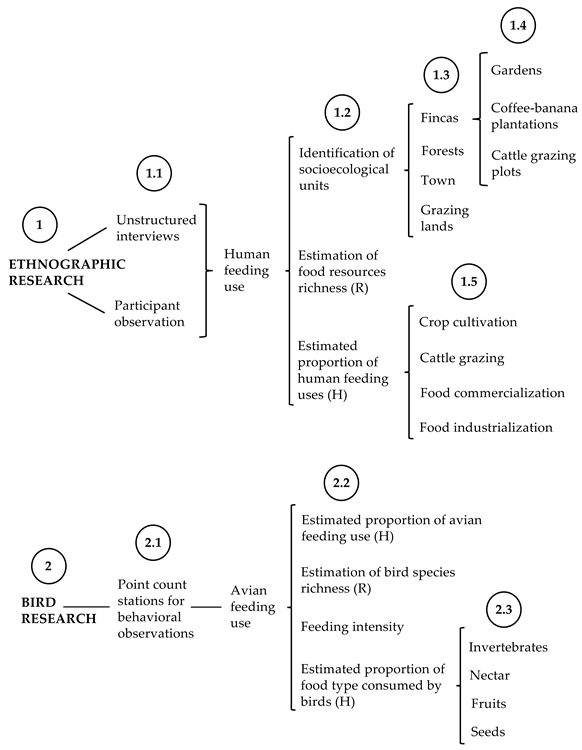
Appendix B
| Food Resource | Section of Fincas | ||
| Scientific Name (Common Name) | Garden | Coffee–Banana | Grazing |
| Allium schoenoprasum (Chives) | 1 | 0 | 0 |
| Allium cepa (Onion) | 5 | 0 | 0 |
| Ananas comosus (Pineapple) | 2 | 0 | 0 |
| Annona cherimola (Custard apple) | 1 | 0 | 0 |
| Arracacia xanthorrhiza (Arracacha) | 1 | 0 | 0 |
| Banana leaf | 0 | 1 | 0 |
| Capsicum sp. (Chili, variety 1) | 0 | 1 | 0 |
| Capsicum sp. (Chili, variety 2) | 0 | 1 | 0 |
| Carica papaya (Papaya) | 4 | 0 | 0 |
| Cheese | 0 | 0 | 3 |
| Chili sauce | 3 | 0 | 0 |
| Citrus aurantifolia (Key lime) | 2 | 0 | 0 |
| Citrus latifolia (Persian lime) | 3 | 0 | 0 |
| Citrus cinensis (Orange) | 6 | 0 | 0 |
| Citrus reticulata (Mandarin orange) | 6 | 0 | 0 |
| Coffea spp. (Coffee) | 2 | 20 | 0 |
| Coriandrum sativum (Cilantro) | 1 | 0 | 0 |
| Cucurbita sp. (Ahuyama) | 1 | 0 | 0 |
| Eggs | 2 | 0 | 0 |
| Eriobotrya japonica (Loquat) | 1 | 0 | 0 |
| Honey | 3 | 0 | 0 |
| Mangifera indica (Mango) | 3 | 0 | 0 |
| Manihot esculenta (Yuca) | 5 | 0 | 0 |
| Milk (goat) | 1 | 0 | 1 |
| Milk (cow) | 0 | 0 | 6 |
| Musa sp. (Banana, variety 1) | 2 | 18 | 0 |
| Musa sp. (Banana, variety 2) | 0 | 2 | 0 |
| Musa sp. (Banana, variety 3) | 0 | 1 | 0 |
| Musa sp. (Banana, variety 4) | 0 | 2 | 0 |
| Musa sp. (Banana, variety 5) | 3 | 14 | 0 |
| Passiflora ligularis (Sweet granadilla) | 0 | 0 | 1 |
| Persea americana (Avocado) | 8 | 7 | 0 |
| Phaseolus vulgaris (Bean) | 8 | 0 | 0 |
| Phaseolus sp. (String bean) | 3 | 0 | 0 |
| Pork | 2 | 0 | 0 |
| Poultry | 2 | 0 | 0 |
| Psidium sp. (Guava, variety 1) | 10 | 1 | 3 |
| Psidium sp. (Guava, variety 2) | 1 | 0 | 0 |
| Psidium sp. (Guava, variety 3) | 1 | 0 | 0 |
| Psidium sp. (Guava, variety 4) | 1 | 0 | 0 |
| Psidium sp. (Guava, variety 5) | 1 | 0 | 0 |
| Psidium sp. (Guava, variety 6) | 1 | 0 | 0 |
| Psidium sp. (Guava, variety 7) | 1 | 0 | 0 |
| Psidium sp. (Guava, variety 8) | 1 | 0 | 0 |
| Psidium sp. (Guava, variety 9) | 1 | 0 | 0 |
| Psidium sp. (Guava, variety 10) | 1 | 0 | 0 |
| Solanum tuberosum (Potato) | 1 | 0 | 0 |
| Solanum lycopersicum (Tomato) | 6 | 0 | 0 |
| Spondias mombin (Yellow mombin) | 4 | 1 | 1 |
| Zea mays (Corn) | 9 | 0 | 0 |
Appendix C
| Group | Forests | Gardens | Coffee-Banana Plantations | Grazing Lands | Town | Total |
| Whole community | 91 | 109 | 120 | 89 | 98 | 507 |
| Invertebrates | 64 | 43 | 69 | 45 | 33 | 254 |
| Fruits | 15 | 33 | 30 | 10 | 1 | 89 |
| Nectar | 3 | 16 | 12 | 8 | 2 | 41 |
| Seeds | 0 | 6 | 0 | 3 | 31 | 40 |
Appendix D
| Family | Socioecological Unit | ||||
| Species | Forest | Coffee | Garden | Grazing | Town |
| Cracidae | |||||
| Ortalis columbiana | 0 | 0 | 1 | 0 | 0 |
| Columbidae | |||||
| Columba livia | 0 | 0 | 0 | 0 | 42 |
| Patagioenas cayennensis | 0 | 1 | 0 | 0 | 0 |
| Columbina talpacoti | 0 | 0 | 0 | 1 | 1 |
| Cuculidae | |||||
| Piaya cayana | 0 | 1 | 0 | 0 | 0 |
| Apodidae | |||||
| Streptoprocne zonaris | 15 | 0 | 0 | 0 | 0 |
| Trochilidae | |||||
| Phaethornis guy | 2 | 2 | 1 | 0 | 0 |
| Anthracothorax nigricollis | 0 | 0 | 1 | 0 | 0 |
| Coeligena coeligena | 1 | 0 | 0 | 0 | 0 |
| Chlorostilbon melanorhynchus | 2 | 3 | 4 | 0 | 0 |
| Saucerottia saucerottei | 0 | 1 | 3 | 0 | 2 |
| Amazilia tzacatl | 0 | 2 | 4 | 1 | 0 |
| Uranomitra franciae | 1 | 0 | 0 | 1 | 0 |
| Trochilidae sp. | 0 | 0 | 1 | 0 | 0 |
| Rallidae | |||||
| Pardirallus nigricans | 0 | 0 | 0 | 2 | 0 |
| Charadriidae | |||||
| Vanellus chilensis | 0 | 0 | 0 | 5 | 0 |
| Ardeidae | |||||
| Bubulcus ibis | 0 | 1 | 0 | 1 | 0 |
| Cathartidae | |||||
| Cathartes aura | 0 | 2 | 0 | 1 | 0 |
| Accipitridae | |||||
| Rupornis magnirostris | 0 | 0 | 0 | 1 | 0 |
| Momotidae | |||||
| Momotus aequatorialis | 2 | 1 | 2 | 0 | 0 |
| Capitonidae | |||||
| Eubucco bourcierii | 2 | 0 | 0 | 0 | 0 |
| Ramphastidae | |||||
| Aulacorhynchus haematopygus | 3 | 0 | 1 | 0 | 0 |
| Picidae | |||||
| Melanerpes formicivorus | 0 | 0 | 1 | 0 | 0 |
| Melanerpes rubricapillus | 0 | 0 | 0 | 1 | 0 |
| Dryobates fumigatus | 2 | 0 | 0 | 0 | 0 |
| Dryocopus lineatus | 1 | 0 | 1 | 0 | 0 |
| Colaptes rubiginosus | 0 | 2 | 0 | 0 | 0 |
| Psittacidae | |||||
| Pionus chalcopterus | 0 | 3 | 0 | 0 | 0 |
| Thamnophilidae | |||||
| Thamnophilus multistriatus | 1 | 0 | 0 | 0 | 0 |
| Furnariidae | |||||
| Lepidocolaptes souleyetii | 3 | 0 | 0 | 0 | 0 |
| Tyrannidae | |||||
| Mionectes oleagineus | 0 | 1 | 0 | 0 | 0 |
| Leptopogon superciliaris | 3 | 2 | 0 | 0 | 0 |
| Tolmomyias sulphurescens | 0 | 1 | 0 | 0 | 0 |
| Todirostrum cinereum | 0 | 1 | 1 | 0 | 0 |
| Zimmerius chrysops | 2 | 2 | 2 | 0 | 0 |
| Camptostoma obsoletum | 1 | 0 | 1 | 1 | 0 |
| Elaenia flavogaster | 0 | 0 | 0 | 1 | 0 |
| Serpophaga cinerea | 0 | 0 | 1 | 0 | 0 |
| Machetornis rixosa | 0 | 0 | 0 | 1 | 0 |
| Myiodynastes chrysocephalus | 0 | 1 | 0 | 0 | 0 |
| Myiozetetes cayanensis | 0 | 0 | 1 | 3 | 0 |
| Tyrannus melancholicus | 0 | 1 | 0 | 6 | 2 |
| Myiarchus sp. | 0 | 1 | 0 | 0 | 0 |
| Sayornis nigricans | 0 | 0 | 2 | 2 | 0 |
| Contopus cooperi | 1 | 0 | 0 | 0 | 0 |
| Contopus cinereus | 0 | 1 | 0 | 1 | 0 |
| Vireonidae | |||||
| Vireo leucophrys | 2 | 0 | 0 | 0 | 0 |
| Vireo chivi | 0 | 1 | 0 | 0 | 0 |
| Corvidae | |||||
| Cyanocorax affinis | 1 | 0 | 1 | 1 | 0 |
| Hirundinidae | |||||
| Pygochelidon cyanoleuca | 0 | 0 | 2 | 9 | 30 |
| Stelgidopteryx ruficollis | 0 | 8 | 9 | 2 | 0 |
| Troglodytidae | |||||
| Troglodytes aedon | 0 | 1 | 1 | 1 | 1 |
| Turdidae | |||||
| Myadestes ralloides | 2 | 0 | 0 | 0 | 0 |
| Turdus ignobilis | 0 | 6 | 1 | 0 | 0 |
| Mimidae | |||||
| Mimus gilvus | 0 | 0 | 0 | 1 | 0 |
| Fringillidae | |||||
| Euphonia laniirostris | 0 | 0 | 5 | 0 | 1 |
| Passerellidae | |||||
| Zonotrichia capensis | 0 | 6 | 4 | 1 | 4 |
| Atlapetes albinucha | 2 | 2 | 0 | 2 | 0 |
| Icteridae | |||||
| Psarocolius angustifrons | 2 | 0 | 0 | 0 | 0 |
| Icterus chrysater | 0 | 2 | 1 | 0 | 0 |
| Quiscalus lugubris | 0 | 0 | 0 | 0 | 6 |
| Quiscalus mexicanus | 0 | 0 | 0 | 0 | 1 |
| Hypopyrrhus pyrohypogaster | 0 | 0 | 1 | 0 | 0 |
| Parulidae | |||||
| Mniotilta varia | 1 | 0 | 0 | 0 | 0 |
| Setophaga ruticilla | 1 | 0 | 0 | 0 | 0 |
| Setophaga fusca | 3 | 2 | 0 | 1 | 0 |
| Setophaga petechia | 0 | 0 | 1 | 0 | 0 |
| Cardellina canadensis | 1 | 0 | 0 | 0 | 0 |
| Myioborus miniatus | 9 | 2 | 1 | 6 | 0 |
| Cardinalidae | |||||
| Piranga flava | 0 | 0 | 0 | 2 | 0 |
| Thraupidae | |||||
| Chlorophanes spiza | 3 | 0 | 1 | 0 | 0 |
| Hemithraupis guira | 0 | 0 | 1 | 0 | 0 |
| Sicalis flaveola | 0 | 0 | 0 | 5 | 0 |
| Volatinia jacarina | 0 | 2 | 0 | 0 | 0 |
| Tachyphonus rufus | 0 | 3 | 0 | 0 | 0 |
| Ramphocelus dimidiatus | 0 | 0 | 1 | 0 | 0 |
| Ramphocelus flammigerus | 0 | 6 | 6 | 2 | 0 |
| Sporophila nigricollis | 0 | 0 | 5 | 0 | 0 |
| Coereba flaveola | 0 | 3 | 5 | 1 | 1 |
| Tiaris olivaceus | 0 | 0 | 0 | 1 | 0 |
| Anisognathus somptuosus | 2 | 0 | 0 | 0 | 0 |
| Stilpnia heinei | 6 | 3 | 3 | 5 | 0 |
| Stilpnia vitriolina | 0 | 8 | 9 | 8 | 1 |
| Stilpnia cyanicollis | 0 | 4 | 4 | 2 | 0 |
| Tangara labradorides | 2 | 0 | 0 | 0 | 0 |
| Tangara gyrola | 7 | 10 | 2 | 2 | 0 |
| Tangara arthus | 3 | 3 | 0 | 2 | 0 |
| Thraupis episcopus | 0 | 8 | 5 | 4 | 3 |
| Thraupis palmarum | 2 | 10 | 12 | 2 | 3 |
References
- Zeder, M.A. The origins of agriculture in the Near East. Curr. Anthropol. 2011, 52, S221–S235. [Google Scholar] [CrossRef] [Green Version]
- Zeder, M.A. Core questions in domestication research. Proc. Natl. Acad. Sci. USA 2015, 112, 3191–3198. [Google Scholar] [CrossRef] [PubMed] [Green Version]
- Clement, C.R.; Casas, A.; Parra-Rondinel, F.A.; Levis, C.; Peroni, N.; Hanazaki, N.; Cortés-Zárraga, L.; Rangel-Landa, S.; Alves, R.P.; Ferreira, M.J.; et al. Disentangling domestication from food production systems in the Neotropics. Quaternay 2021, 4, 4. [Google Scholar] [CrossRef]
- FAO. Uso de la Tierra en la Agricultura Según las Cifras; Organización de las Naciones Unidas Para la Alimentación y la Agricultura: Santiago, Chile, 2020. [Google Scholar]
- Salcedo, S.; Guzmán, L. Agricultura Familiar en América Latina y el Caribe: Recomendaciones de Política; Organización de las Naciones Unidas para la Alimentación y la Agricultura: Santiago, Chile, 2014. [Google Scholar]
- von Wehrden, H.; Abson, D.J.; Beckmann, M.; Cord, A.F.; Klotz, S.; Seppelt, R. Realigning the land-sharing/land-sparing debate to match conservation needs: Considering diversity scales and land-use history. Landsc. Ecol. 2014, 29, 941–948. [Google Scholar] [CrossRef]
- Bezaury-Creel, J.; Graf-Montero, S.; Barcklay-Briseño, K.; de la Maza-Hernández, R.; Machado-Macías, J.S.; Rodríguez-Martínez del Sobral, E.; Rojas-González de Castilla, S.; Ruíz-Barranco, H. Los Paisajes Bioculturales, un Instrumento Para el Desarrollo Rural y la Conservación del Patrimonio Natural y Cultural; Comisión Nacional de Áreas Naturales Protegidas, Agencia Francesa de Desarrollo: Ciudad de México, México, 2015. [Google Scholar]
- Moreno-Calles, A.; Casas, A.; Blancas, J.; Torres, I.; Peréz-Negrón, E.; Caballero, J.; Masera, O.; García-Barrios, L. Agroforestry systems and biodiversity conservation in arid zones: The case of the Tehuacán-Cuicatlán Valley, Central Mexico. Agrofor. Syst. 2010, 80, 315–331. [Google Scholar] [CrossRef]
- Vallejo, M.; Casas, A.; Blancas, J.; Moreno-Calles, A.I.; Solís, L.; Rangel-Landa, S.; Dávila, P.; Téllez, O. Agroforestry systems in the highlands of the Tehuacán Valley, Mexico: Indigenous culture and biodiversity conservation. Agrofor. Syst. 2014, 88, 125–140. [Google Scholar] [CrossRef]
- Vallejo, M.; Ramírez, I.; Reyes-González, A.; Moreno-Calles, A.I.; Casas, A. Agroforestry systems of the Tehuacán Valley: Changes and maintenance of their distribution at regional level. Land 2019, 8, 1–26. [Google Scholar]
- Rendón-Sandoval, F.J.; Casas, A.; Moreno-Calles, A.I.; Torres-García, I.; García Frapolli, E. Traditional agroforestry systems and conservation of native plant diversity of seasonally dry tropical forests. Sustainability 2020, 12, 4600. [Google Scholar] [CrossRef]
- Chappell, M.J.; LaValle, L.A. Food security and biodiversity: Can we have both? An agroecological analysis. Agric. Hum. Values 2011, 28, 3–26. [Google Scholar] [CrossRef]
- Freudmann, A.; Mollik, P.; Tschapka, M.; Schulze, C.H. Impacts of oil palm agriculture on phyllostomid bat assemblages. Biodivers. Conserv. 2015, 24, 3583–3599. [Google Scholar] [CrossRef]
- Casas, A.; Parra, F.; Blancas, J.; Rangel-Landa, S.; Vallejo, M.; Figueredo, C.J.; Moreno-Calles, A.I. Origen de la domesticación y la agricultura: Cómo y por qué. In Domesticación en el Continente Americano. Volumen 1. Manejo de Biodiversidad y Evolución Dirigida por las Culturas del Nuevo Mundo; Casas, A., Torres-Guevara, J., Parra, F., Eds.; UNAM-UNALM: Morelia, México, 2016; pp. 189–224. [Google Scholar]
- Boege, E. El Patrimonio Biocultural de los Pueblos Indígenas de México; Instituto Nacional de Antropología e Historia, Comisión Nacional Para el Desarrollo de los Pueblos Indígenas: Ciudad de México, México, 2008. [Google Scholar]
- Toledo, V.M. El paradigma biocultural: Crisis ecológica, modernidad y culturas tradicionales. Soc. Ambiente 2013, 1, 50–60. [Google Scholar] [CrossRef]
- Lemon, W.C. Fitness consequences of foraging behaviour in the zebra finch. Nature 1991, 352, 153–155. [Google Scholar] [CrossRef]
- Wong, B.B.M.; Candolin, U. Behavioral responses to changing environments. Behav. Ecol. 2015, 26, 665–673. [Google Scholar] [CrossRef] [Green Version]
- Chambers, S.A. Birds as Environmental Indicators: Review of Literature; Parks Victoria Technical Series No. 55; Parks Victoria: Melbourne, Australia, 2008. [Google Scholar]
- Tidemann, S.; Gosler, A.G. Ethno-Ornithology: Birds, Indigenous Peoples, Culture and Society; Earthscan: London, UK, 2010. [Google Scholar]
- Harris, C.D.; Ullman, E.L. The nature of cities. Ann. Am. Acad. Polit. Soc. Sci. 1945, 242, 7–17. [Google Scholar] [CrossRef]
- Galhena, D.H.; Freed, R.; Maredia, K.M. Home gardens: A promising approach to enhance household food security and wellbeing. Agric. Food Secur. 2013, 2, 1–13. [Google Scholar] [CrossRef] [Green Version]
- Seress, G.; Hammer, T.; Bókony, V.; Vincze, E.; Preiszner, B.; Pipoly, I.; Sinkovics, C.; Evans, K.L.; Liker, A. Impact of urbanization on abundance and phenology of caterpillars and consequences for breeding in an insectivorous bird. Ecol. Appl. 2018, 28, 1143–1156. [Google Scholar] [CrossRef] [Green Version]
- Lim, H.C.; Sodhi, N.S. Responses of avian guilds to urbanisation in a tropical city. Landsc. Urban. Plan. 2004, 66, 199–215. [Google Scholar] [CrossRef]
- Davis, A.; Major, R.E.; Taylor, C.E. The association between nectar availability and nectarivore density in urban and natural environments. Urban. Ecosyst. 2015, 18, 503–515. [Google Scholar] [CrossRef] [Green Version]
- Ortega-Álvarez, R.; MacGregor-Fors, I. Dusting-off the file: A review of knowledge on urban ornithology in Latin America. Landsc. Urban. Plan. 2011, 101, 1–10. [Google Scholar] [CrossRef]
- Ikin, K.; Knight, E.; Lindenmayer, D.B.; Fischer, J.; Manning, A.D. Linking bird species traits to vegetation characteristics in a future urban development zone: Implications for urban planning. Urban. Ecosyst. 2012, 15, 961–977. [Google Scholar] [CrossRef]
- Narango, D.L.; Tallamy, D.W.; Snyder, K.J.; Rice, R.A. Canopy tree preference by insectivorous birds in shade-coffee farms: Implications for migratory bird conservation. Biotropica 2019, 51, 387–398. [Google Scholar] [CrossRef]
- Cardona Sánchez, J.F. Cafés Especiales: Situación Actual y Aplicación del Programa de Calidad de Café Nespresso AAA, en el Municipio de Jardín Antioquia. Ph.D. Thesis, Corporación Universitaria Lasallista, Caldas, Antioquia, 2010. [Google Scholar]
- Marín Duque, L.J. Prácticas Culturales y Culinarias Alrededor del Turismo Cafetero: Municipio de Jardín de Antioquia. Ph.D. Thesis, Universidad de Antioquia, Andes, Antioquia, 2021. [Google Scholar]
- Orejuela-Gartner, J. Orquídeas de los bosques de niebla del suroccidente de Colombia y oportunidades para su conservación. Lankesteriana 2013, 13, 152. [Google Scholar] [CrossRef] [Green Version]
- Municipio de Jardín. Acuerdo N°16. Por Medio del Cual se Adopta la Revisión y Ajuste de Largo Plazo, del Esquema de Ordenamiento Territorial del Municipio de Jardín; Municipio de Jardín, Departamento de Antioquia, Colombia: Jardín, Colombia, 2018. [Google Scholar]
- Holdridge, L.R. Determination of world plant formations from simple climatic data. Science 1947, 105, 367–368. [Google Scholar] [CrossRef] [PubMed]
- Corantioquia. Plan de Manejo Ambiental. Parte alta de la Microcuenca La Linda. Municipio de Jardín, Antioquia; Corporación Autónoma Regional del Centro de Antioquia, CORANTIOQUIA: Medellín, Colombia, 2002. [Google Scholar]
- Toro Murillo, J.L. Árboles de las Montañas de Antioquia; Corporación Autónoma Regional del Centro de Antioquia, CORANTIOQUIA: Medellín, Colombia, 2012. [Google Scholar]
- Drury, R.; Homewood, K.; Randall, S. Less is more: The potential of qualitative approaches in conservation research. Anim. Conserv. 2011, 14, 18–24. [Google Scholar] [CrossRef]
- Boege, E. Protegiendo lo Nuestro: Manual Para la Gestión Ambiental Comunitaria, Uso y Conservación de la Biodiversidad de los Campesinos Indígenas de América Latina; Programas de las Naciones Unidas para el Medio Ambiente; Fondo para el Desarrollo de los Pueblos Indígenas de América Latina y el Caribe: Ciudad de México, Mexico, 2005. [Google Scholar]
- Kruschke, J.K. Doing Bayesian Data Analysis: A Tutorial with R, JAGS, and STAN, 2nd ed.; Academic Press: Cambridge, MA, USA, 2015. [Google Scholar]
- Gelman, A.; Rubin, D.B. Inference from iterative simulation using multiple sequences. Stat. Sci. 1992, 7, 457–511. [Google Scholar] [CrossRef]
- Baath, R. Bayesian First Aid: A package that implements Bayesian alternatives to the classical *.test functions in R. In Proceedings of the UseR! 2014—The International R User Conference, Los Angeles, CA, USA, 14–18 July 2014. [Google Scholar]
- Plummer, M. JAGS: A Program for Analysis of Bayesian Graphical Models Using Gibbs Sampling. In Proceedings of the 3rd International Workshop on Distributed Statistical Computing, Vienna, Austria, 20–22 March 2003. [Google Scholar]
- R Core Team. R: A Language and Environment for Statistical Computing; R Foundation for Statistical Computing: Vienna, Austria, 2020; Available online: http://www.r-project.org/ (accessed on 1 December 2021).
- Hsieh, T.C.; Ma, K.H.; Chao, A. iNEXT: An R package for rarefaction and extrapolation of species diversity (Hill numbers). Methods Ecol. Evol. 2016, 7, 1451–1456. [Google Scholar] [CrossRef]
- Bibby, C.; Burgess, N.; Hill, D.; Mustoe, S. Bird Census Techniques; Academic Press: London, UK, 2000. [Google Scholar]
- Ruiz Gutiérrez, V.; Berlanga García, H.A.; Calderón-Parra, R.; Savarino Drago, A.; Aguilar-Gómez, M.Á.; Rodríguez-Contreras, V. Manual Ilustrado para el Monitoreo de Aves. PROALAS: Programa de América Latina Para las Aves Silvestres; Comisión Nacional Para el Conocimiento y Uso de la Biodiversidad/Iniciativa Para la Conservación de las Aves de Norte América, Laboratorio de Ornitología de Cornell: Ciudad de México, Mexico, 2020. [Google Scholar]
- Wagner, J.L. Visibility and bias in avian foraging data. Condor 1981, 83, 263–264. [Google Scholar] [CrossRef]
- Acevedo, M.A. Bird feeding behavior as a measure of restoration success in a Caribbean Forested Wetland. Ornitol. Neotrop. 2007, 18, 305–310. [Google Scholar]
- Ocampo, J.; Wyckhuys, K. Tecnología Para el Cultivo de la Gulupa (Passiflora edulis f. edulis Sims) en Colombia; Centro de Bio-Sistemas de la Universidad Jorge Tadeo Lozano, Centro Internacional de Agricultura Tropical, Ministerio de Agricultura y Desarrollo Rural: Bogotá, Colombia, 2012. [Google Scholar]
- FAO. El estado Mundial de la Agricultura y la Alimentación; Organización de las Naciones Unidas Para la Alimentación y la Agricultura: Roma, Italy, 2016. [Google Scholar]
- Talukder, A.; Kiess, L.; Huq, N.; de Pee, S.; Darnton-Hill, I.; Bloem, M.W. Increasing the production and consumption of vitamin A–rich fruits and vegetables: Lessons learned in taking the Bangladesh homestead gardening programme to a national scale. Food Nutr. Bull. 2000, 21, 165–172. [Google Scholar] [CrossRef]
- Calvet-Mir, L.; Gómez-Bagetthun, E.; Reyes-García, V. Beyond food production: Home gardens ecosystem services. A case study in Vall Fosca, Catalan Pyrenees, Northeastern Spain. Ecol. Econ. 2012, 74, 153–160. [Google Scholar] [CrossRef]
- Sontia, N.F.; Svendsen, E.S. Why garden? Personal and abiding motivations for community gardening in New York City. Soc. Nat. Resour. 2018, 31, 1189–1205. [Google Scholar] [CrossRef]
- Goulart, F.F.; Carvalho-Ribeiro, S.; Soares-Filho, B. Farming-biodiversity segregation or integration? Revisiting land sparing versus land sharing debate. J. Environ. Prot. 2016, 7, 1016–1032. [Google Scholar] [CrossRef] [Green Version]
- Suarez-Rubio, M.; Thomlinson, J.R. Landscape and patch-level factors influence bird communities in an urbanized tropical island. Biol. Conserv. 2009, 142, 1311–1321. [Google Scholar] [CrossRef]
- Morante-Filho, J.C.; Benchimol, M.; Faria, D. Landscape composition is the strongest determinant of bird occupancy patterns in tropical forest patches. Landsc. Ecol. 2021, 36, 105–117. [Google Scholar] [CrossRef]
- Ortega-Álvarez, R.; Ruiz-Gutiérrez, V.; Robinson, O.J.; Berrones Benítez, E.; Medina Mena, I.; Zúñiga-Vega, J.J. Beyond incidence data: Assessing bird habitat use in indigenous working landscapes through the analysis of behavioral variation among land uses. Landsc. Urban. Plan. 2021, 211, 104100. [Google Scholar] [CrossRef]
- Auman, H.J.; Meathrel, C.E.; Richardson, A. Supersize me: Does anthropogenic food change the body condition of Silver Gulls? A comparison between urbanized and remote, non-urbanized areas. Waterbirds 2008, 31, 122–126. [Google Scholar] [CrossRef]
- Leveau, L.M. Artificial Light at Night (ALAN) is the main driver of nocturnal Feral Pigeon (Columba livia f. domestica) foraging in urban areas. Animals 2020, 10, 554. [Google Scholar] [CrossRef] [Green Version]
- Jones, D.N.; James Reynolds, S. Feeding birds in our towns and cities: A global research opportunity. J. Avian Biol. 2008, 39, 265–271. [Google Scholar] [CrossRef] [Green Version]
- Maron, M.; Lill, A. The influence of livestock grazing and weed invasion on habitat use by birds in grassy woodland remnants. Biol. Conserv. 2005, 124, 439–450. [Google Scholar] [CrossRef]
- Dennis, P.; Skartveit, J.; McCracken, D.I.; Pakeman, R.J.; Beaton, K.; Kunaver, A.; Evans, D.M. The effects of livestock grazing on foliar arthropods associated with bird diet in upland grasslands of Scotland. J. Appl. Ecol. 2008, 45, 279–287. [Google Scholar] [CrossRef]
- Castaño-Villa, G.J.; Ramos-Valencia, S.A.; Fontúrbel, F.E. Fine-scale habitat structure complexity determines insectivorous bird diversity in a tropical forest. Acta Oecol. 2014, 61, 19–23. [Google Scholar] [CrossRef]
- Komar, O. Ecology and conservation of birds in coffee plantations: A critical review. Bird Conserv. Int. 2006, 16, 1–23. [Google Scholar] [CrossRef] [Green Version]
- Leyequién, E.; de Boer, W.F.; Toledo, V.M. Bird community composition in a shaded coffee agro-ecological matrix in Puebla, Mexico: The effects of landscape heterogeneity at multiple spatial scales. Biotropica 2010, 42, 236–245. [Google Scholar] [CrossRef]
- Mastrangelo, M.E.; Gavin, M.C. Impacts of agricultural intensification on avian richness at multiple scales in Dry Chaco forests. Biol. Conserv. 2014, 179, 63–71. [Google Scholar] [CrossRef]
- Silva, C.P.; Sepúlveda, R.D.; Barbosa, O. Nonrandom filtering effect on birds: Species and guilds response to urbanization. Ecol. Evol. 2016, 6, 3711–3720. [Google Scholar] [CrossRef]
- Vázquez-Reyes, L.D.; Arizmendi, M.D.C.; Godínez-Álvarez, H.O.; Navarro-Sigüenza, A.G. Directional effects of biotic homogenization of bird communities in Mexican seasonal forests. Condor 2017, 119, 275–288. [Google Scholar] [CrossRef] [Green Version]
- McKinney, M.L.; Lockwood, J.L. Biotic homogenization: A few winners replacing many losers in the next mass extinction. Trends Ecol. Evol. 1999, 14, 450–453. [Google Scholar] [CrossRef]
- Devictor, V.; Julliard, R.; Clavel, J.; Jiguet, F.; Lee, A.; Couvet, D. Functional biotic homogenization of bird communities in disturbed landscapes. Glob. Ecol. Biogeogr. 2008, 17, 252–261. [Google Scholar] [CrossRef]
- Shochat, E. Credit or debit? Resource input changes population dynamics of city-slicker birds. Oikos 2004, 106, 622–626. [Google Scholar] [CrossRef]
- Leveau, L.M.; Zuria, I. Flocking the city: Avian demography and population dynamics in urban Latin America. In Avian Ecology in Latin American Cityscapes; MacGregor-Fors, I., Escobar-Ibáñez, J.F., Eds.; Springer International Publishing AG: Cham, Switzerland, 2017; pp. 57–77. [Google Scholar]
- Cristaldi, M.A.; Giraudo, A.R.; Arzamendia, V.; Bellini, G.P.; Claus, J. Urbanization impacts on the trophic guild composition of bird communities. J. Nat. Hist. 2017, 51, 2385–2404. [Google Scholar] [CrossRef]
- Ghadiri Khanaposhtani, M.; Kaboli, M.; Karami, M.; Etemad, V. Effect of habitat complexity on richness, abundance and distributional pattern of forest birds. Environ. Manag. 2012, 50, 296–303. [Google Scholar] [CrossRef] [PubMed]
- Arnold, K.E.; Ramsay, S.L.; Donaldson, C.; Adam, A. Parental prey selection affects risk-taking behaviour and spatial learning in avian offspring. Proc. R. Soc. B Biol. Sci. 2007, 274, 2563–2569. [Google Scholar] [CrossRef] [PubMed] [Green Version]
- Arnold, K.E.; Ramsay, S.L.; Henderson, L.; Larcombe, S.D. Seasonal variation in diet quality: Antioxidants, invertebrates and blue tits Cyanistes caeruleus. Biol. J. Linn. Soc. 2010, 99, 708–717. [Google Scholar] [CrossRef] [Green Version]
- Durães, R.; Marini, M.Â. A quantitative assessment of bird diets in the Brazilian Atlantic forest, with recommendations for future diet studies. Ornitol. Neotrop. 2005, 16, 65–83. [Google Scholar]
- Moran, A.J.; Prosser, S.W.J.; Moran, J.A. DNA metabarcoding allows non-invasive identification of arthropod prey provisioned to nestling Rufous hummingbirds (Selasphorus rufus). PeerJ 2019, 2019, 1–21. [Google Scholar] [CrossRef] [Green Version]
- Maleque, M.A.; Maeto, K.; Ishii, H.T. Arthropods as bioindicators of sustainable forest management, with a focus on plantation forests. Appl. Entomol. Zool. 2009, 44, 1–11. [Google Scholar] [CrossRef] [Green Version]
- González, G.; Lodge, D.J. Soil biology research across latitude, elevation and disturbance gradients: A review of forest studies from Puerto Rico during the past 25 years. Forests 2017, 8, 178. [Google Scholar] [CrossRef] [Green Version]
- Fenoglio, M.S.; Rossetti, M.R.; Videla, M. Negative effects of urbanization on terrestrial arthropod communities: A meta-analysis. Glob. Ecol. Biogeogr. 2020, 29, 1412–1429. [Google Scholar] [CrossRef]
- Lill, A. Food resources and urban colonisation by Lorikeets and Parrots. Vic. Nat. 2009, 126, 70–72. [Google Scholar]
- Li, N.; Yang, W.; Fang, S.; Li, X.; Liu, Z.; Leng, X.; An, S. Dispersal of invasive Phytolacca americana seeds by birds in an urban garden in China. Integr. Zool. 2017, 12, 26–31. [Google Scholar] [CrossRef]
- Federman, S.; Sinnott-Armstrong, M.; Baden, A.L.; Chapman, C.A.; Daly, D.C.; Richard, A.R.; Valenta, K.; Donoghue, M.J. The paucity of frugivores in Madagascar may not be due to unpredictable temperatures or fruit resources. PLoS ONE 2017, 12, e0168943. [Google Scholar] [CrossRef] [PubMed]
- von Helversen, D.; von Helversen, O. Object recognition by echolocation: A nectar-feeding bat exploiting the flowers of a rain forest vine. J. Comp. Physiol. A 2003, 189, 327–336. [Google Scholar] [CrossRef] [PubMed]
- Maas, B.; Karp, D.S.; Bumrungsri, S.; Darras, K.; Gonthier, D.; Huang, J.C.-C.; Lindell, C.A.; Maine, J.J.; Mestre, L.; Michel, N.L.; et al. Bird and bat predation services in tropical forests and agroforestry landscapes. Biol. Rev. 2016, 91, 1081–1101. [Google Scholar] [CrossRef] [PubMed] [Green Version]
- Duchelle, A. Observations on natural resource use and conservation by the Shuar in Ecuador’s Cordillera del Cóndor. Ethnobot. Res Appl. 2007, 5, 5–23. [Google Scholar] [CrossRef] [Green Version]
- Jernigan, K.; Dauphiné, N. Aguaruna knowledge of bird foraging ecology: A comparison with scientific data. Ethnobot. Res. Appl. 2008, 6, 93–106. [Google Scholar] [CrossRef] [Green Version]
- Hohbein, R.R.; Nibbelink, N.P.; Cooper, R.J. Non-governmental organizations improve the social-ecological fit of institutions conserving the Andean bear in Colombia. Ecol. Soc. 2021, 26, 13. [Google Scholar] [CrossRef]
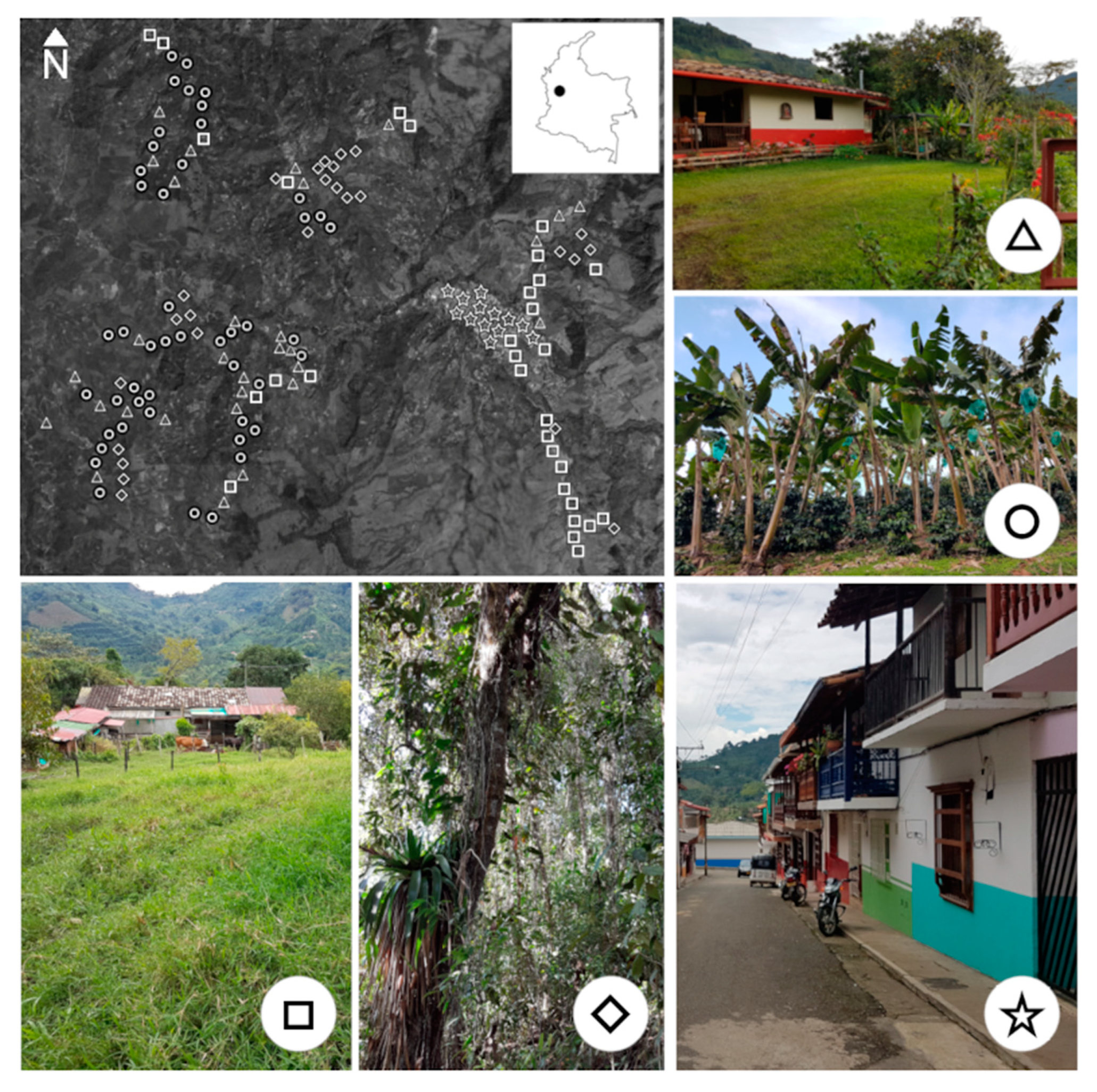
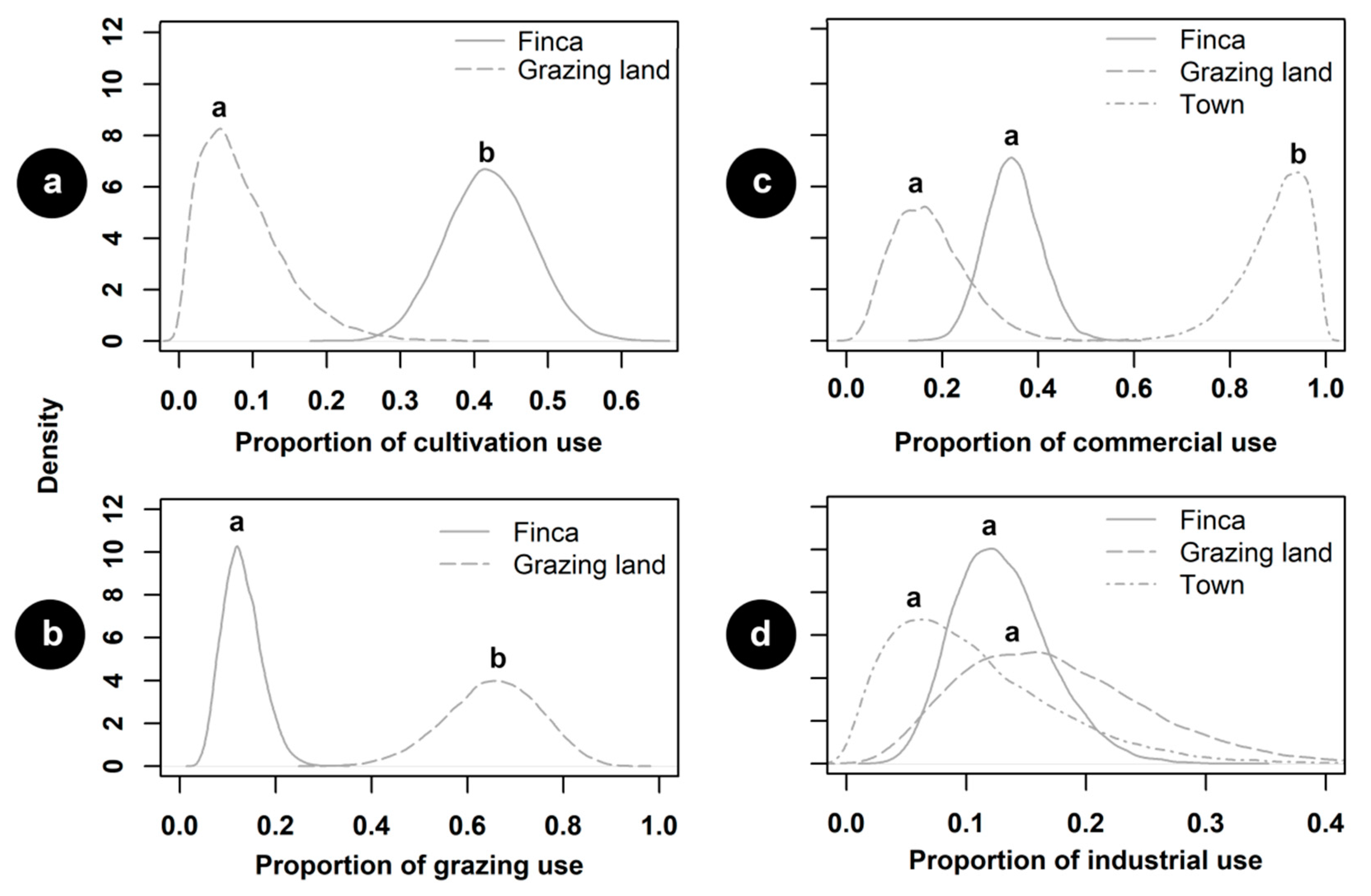
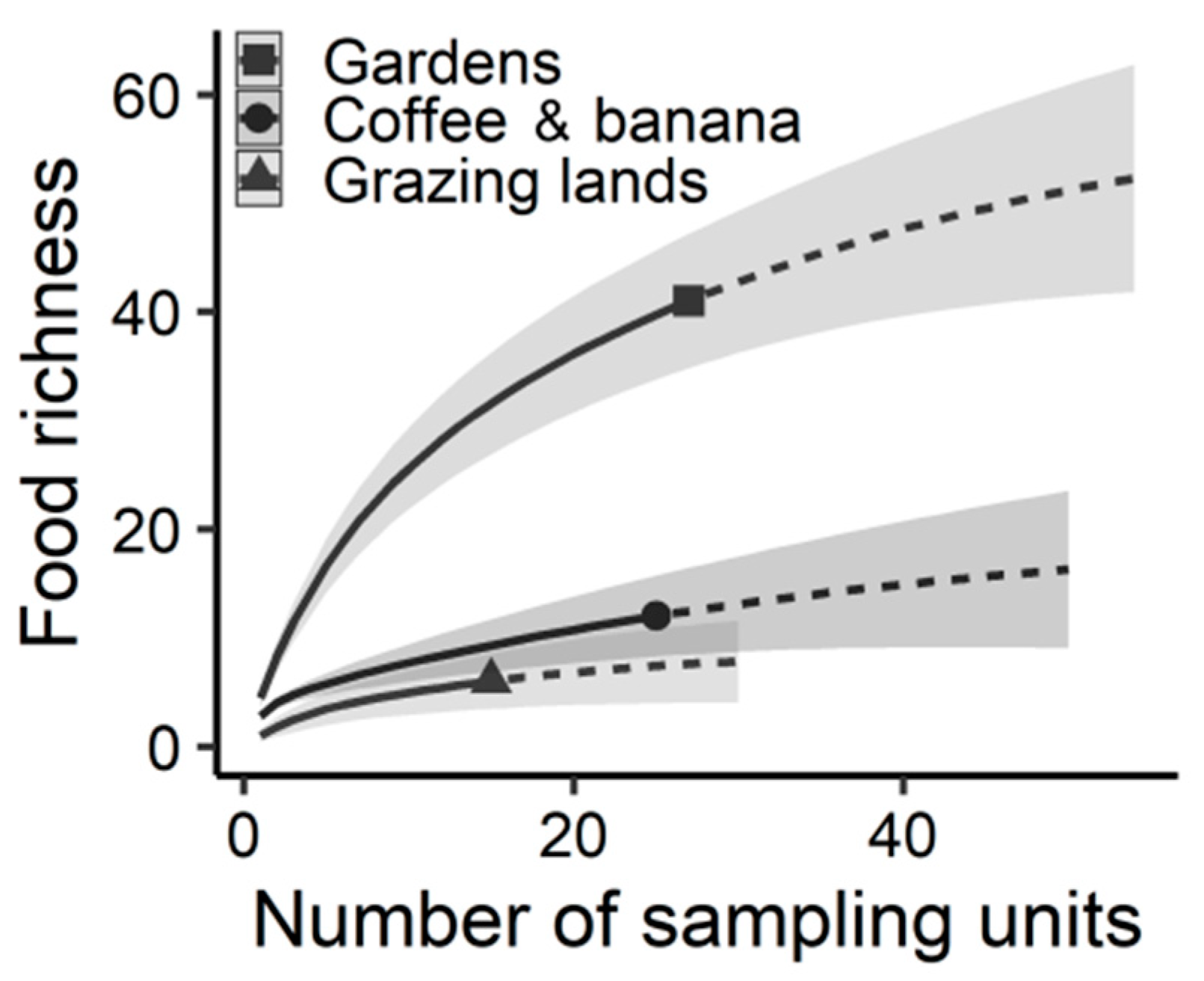
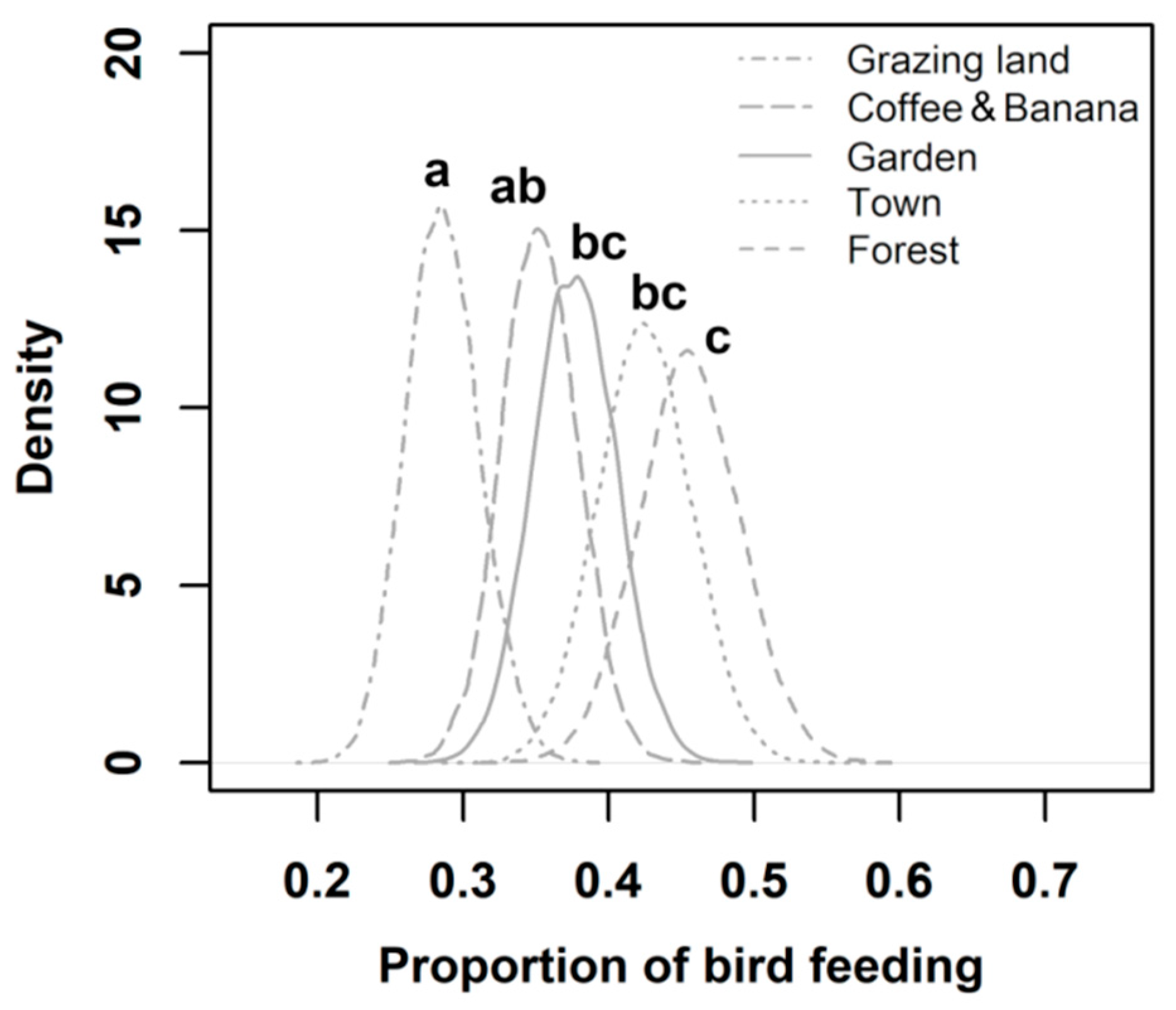
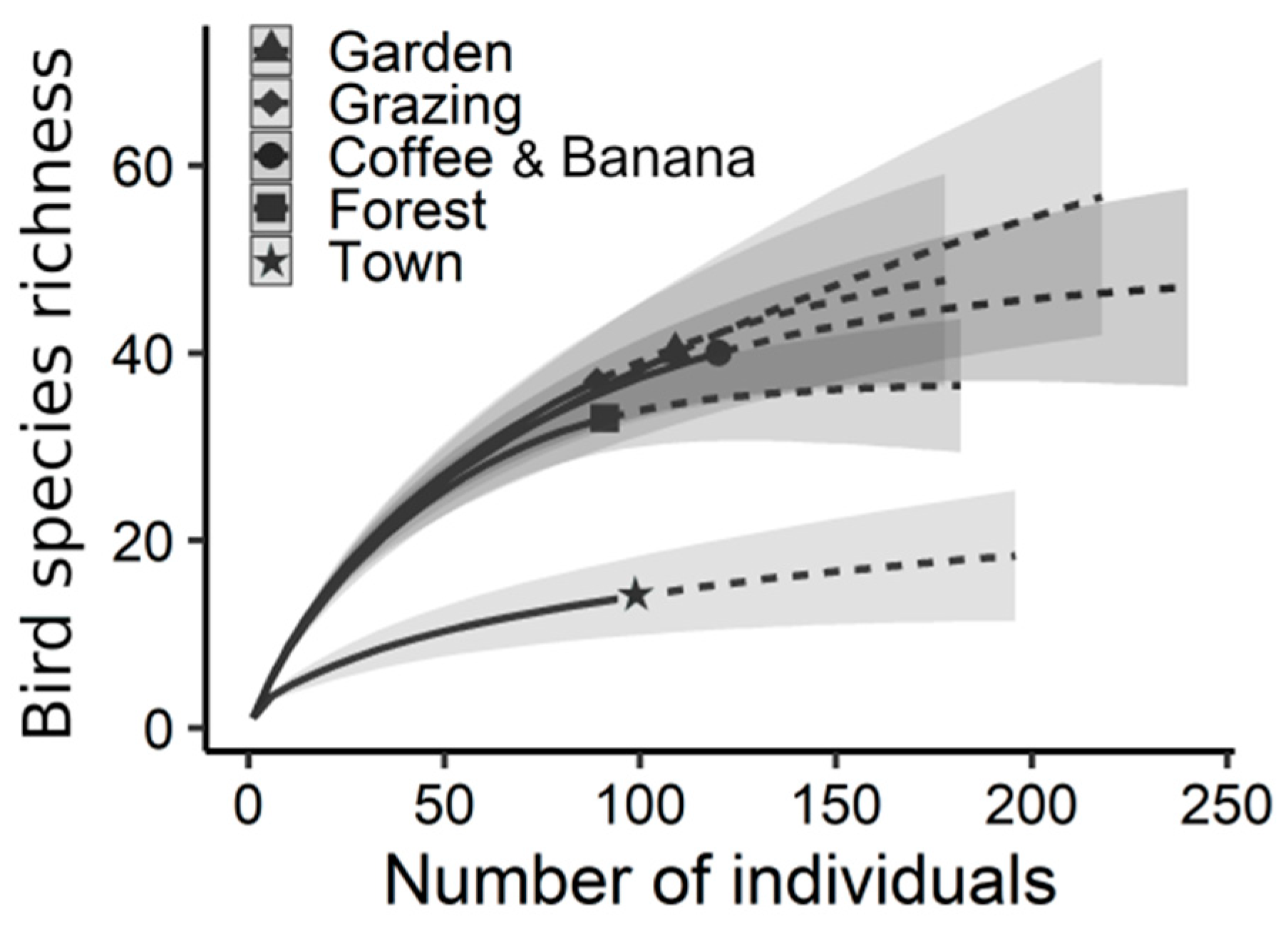
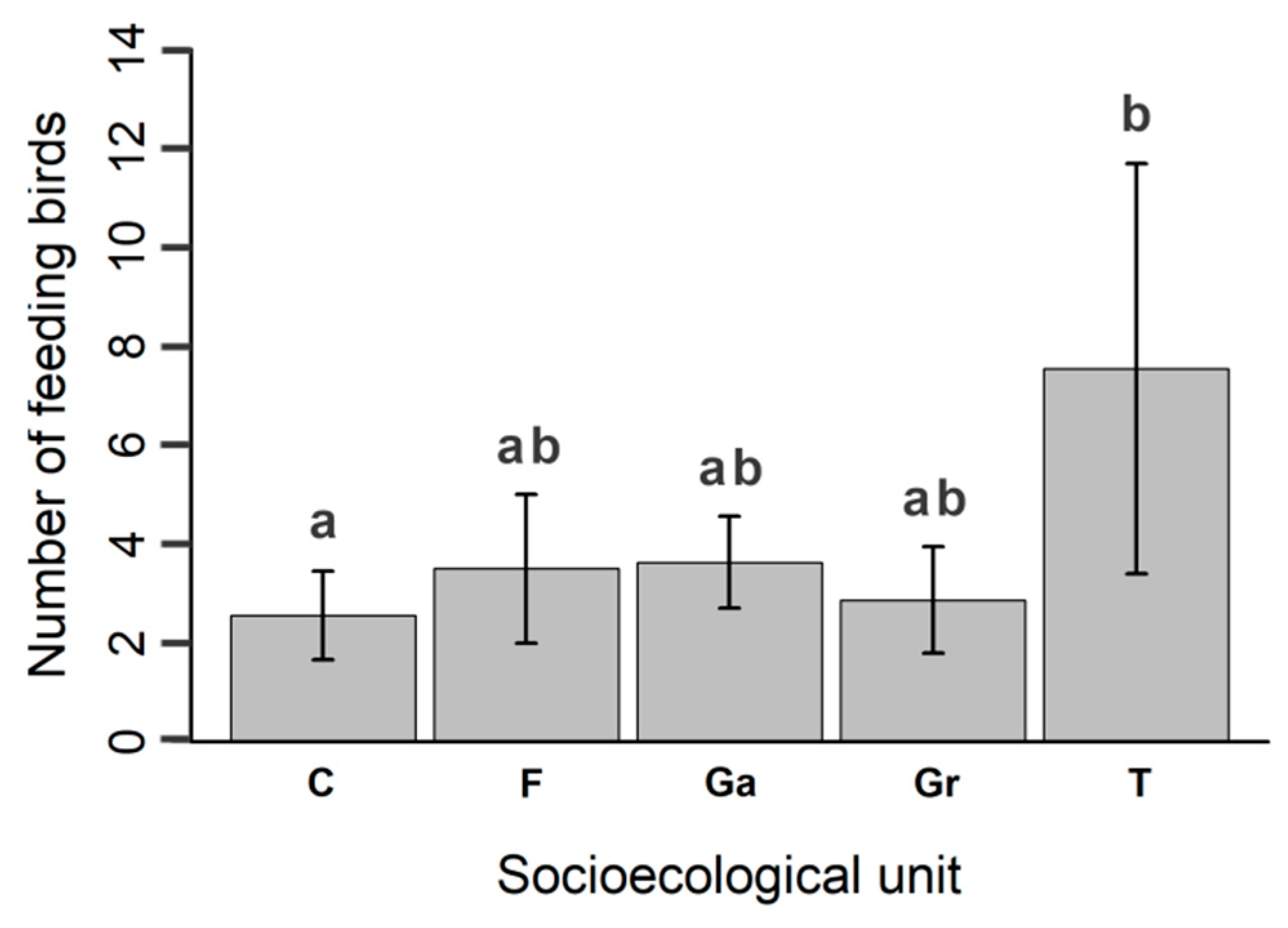

| Unit | Activity | ||||
|---|---|---|---|---|---|
| Crop Cultivation | Cattle Grazing | Commercialization | Industrialization | Total | |
| Fincas | 28 | 8 | 23 | 8 | 67 |
| Grazing lands | 1 | 14 | 3 | 3 | 21 |
| Town | 0 | 0 | 16 | 1 | 17 |
| Forests | 0 | 0 | 0 | 0 | 0 |
Publisher’s Note: MDPI stays neutral with regard to jurisdictional claims in published maps and institutional affiliations. |
© 2022 by the authors. Licensee MDPI, Basel, Switzerland. This article is an open access article distributed under the terms and conditions of the Creative Commons Attribution (CC BY) license (https://creativecommons.org/licenses/by/4.0/).
Share and Cite
Ortega-Álvarez, R.; Casas, A. The Feeding Landscape: Bird and Human Use of Food Resources across a Biocultural Landscape of the Colombian Andes. Sustainability 2022, 14, 4789. https://doi.org/10.3390/su14084789
Ortega-Álvarez R, Casas A. The Feeding Landscape: Bird and Human Use of Food Resources across a Biocultural Landscape of the Colombian Andes. Sustainability. 2022; 14(8):4789. https://doi.org/10.3390/su14084789
Chicago/Turabian StyleOrtega-Álvarez, Rubén, and Alejandro Casas. 2022. "The Feeding Landscape: Bird and Human Use of Food Resources across a Biocultural Landscape of the Colombian Andes" Sustainability 14, no. 8: 4789. https://doi.org/10.3390/su14084789






